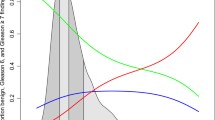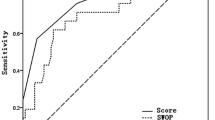Abstract
To assess the diagnostic efficacy of prostate-specific antigen (PSA)-related parameters, using a total of 226 patients with gray zone PSA who underwent prostate biopsy, various cutoff points of free to total ratio of PSA (f/t PSA) and PSA velocity (PSAV) were evaluated. Higher cutoff points of f/t PSA resulted in high sensitivity and negative predictive value (NPV): at f/t PSA <15%, sensitivity was 82.0% (41/50) and NPV 84.7% (50/59), and at f/t PSA <20%, 96.0% (48/50) and 92.3% (24/26). Lowering cutoff points also resulted in higher sensitivity and NPV: at PSAV ≥0.75 ng/ml per year, sensitivity was 71.4% (15/21) and NPV 82.4% (28/34), and at PSAV ≥0.40 ng/ml per year, 95.2% (20/21) and 95.2% (20/21). Further, among the patients with both of these parameters available, both sensitivity and NPV achieved 100% (10/10 and 7/7) when the indication for biopsy was determined as f/t PSA <15% or PSAV ≥0.40 ng/ml per year. Our results showed that unnecessary prostate biopsies could be more effectively avoided among patients with “gray zone PSA” by combination of f/t PSA and PSAV than single usage of these indexes.



Similar content being viewed by others
References
Partin AW, Oesteling JE (1994) The clinical usefulness of prostate specific antigen: update. J Urol 152:1358–1368
Stamey TA, Yang N, Hay AR et al (1987) Prostate-specific antigen as a serum marker for adenoxarcinoma of the prostate. N Engl J Med 317:909–916
Catalona WJ, Smith DS, Ratliff TL et al (1991) Measurement of prostate-specific antigen in serum as a screening test for prostate cancer. N Engl J Med 324:1156–1161
Catalona WJ, Richie JP, Ahmann FR et al (1994) Comparison of digital rectal examination and serum prostate specific antigen in the early detection of prostate cancer: results of a multicenter clinical trial of 6630 men. J Urol 151:1283–1290
Partin AW, Oesterling JE (1996) The clinical usefulness of percent free prostate-specific antigen. Urology 48(6A Suppl):1–87
Catalona WJ, Partin AW, Slawin KM et al (1998) Use of the percentage of free prostate-specific antigen to enhance differentiation of prostate cancer from benign prostate disease: a prospective multicenter clinical trial. JAMA 279:1542–1547
Catalona WJ, Southwick PC, Slawin KM et al (2000) Comparison of percent free PSA, PSA density, and age-specific PSA cutoffs for prostate cancer detection and staging. Urology 56:255–260
Beduschi MC, Oesteling JE (1997) Prostate-specific antigen density. Urol Clin North Am 24:323–332
Carter HB, Pearson JD (1997) Prostate-specific antigen velocity and repeated measures of prostate-specific antigen. Urol Clin North Am 24:333–338
Djavan B, Remzi M, Zlotta AR et al (1999) Combination and multivariate analysis of PSA-based parameters for prostate cancer prediction. Tech Urol 5:71–76
Djavan B, Remzi M, Zlotta A et al (2002) Novel artificial neural network for early detection of prostate cancer. J Clin Oncol 20:921–929
Beduschi MC, Oesteling JE (1998) Percent free prostate-specific antigen: the next frontier in prostate-specific antigen testing. Urology 51(5A Suppl):98–109
Djavan B, Zlotta AR, Byttebier G et al (1998) Prostate specific antigen density of the transition zone for early detection of prostate cancer. J Urol 160:411–419
Bangma CH, Rietbergen JB, Kranse R et al (1997) The free-to-total prostate specific antigen ratio improves the specificity of prostate specific antigen in screening for prostate cancer in the general population. J Urol 157:2191–2196
Morote J, Raventos CX, Lorente JA et al (1997) Comparison of percent free prostate specific antigen and prostate specific antigen density as methods to enhance prostate specific antigen specificity in early prostate cancer detection in men with normal rectal examination and prostate specific antigen between 4.1 and 10 ng/ml. J Urol 158:502–504
Zlotta AR, Djavan B, Petein M et al (1998) Prostate specific antigen density of the transition zone for predicting pathological stage of localized prostate cancer in patients with serum prostate specific antigen less than 10 ng/ml. J Urol 160:2089–2095
Carter HB, Pearson JD, Metter EJ et al (1992) Longitudinal evaluation of prostate-specific antigen levels in men with and without prostate disease. JAMA 267:2215–2220
Mettlin C, Littrup PJ, Kane RA et al (1994) Relative sensitivity and specificity of serum prostate specific antigen (PSA) level compared with age-referenced PSA, PSA density, and PSA change. Data from the American Cancer Society National Prostate Cancer Detection Project Cancer 74:1615–1620
Smith DS, Catalona WJ (1994) Rate of change in serum prostate specific antigen levels as a method for prostate cancer detection. J Urol 152:1163–1167
Author information
Authors and Affiliations
Corresponding author
Rights and permissions
About this article
Cite this article
Yamamoto, S., Maruyama, T., Kondoh, N. et al. Diagnostic efficacy of free to total ratio of prostate-specific antigen and prostate-specific antigen velocity, singly and in combination, in detecting prostate cancer in patients with total serum prostate-specific antigen between 4 and 10 ng/ml. Int Urol Nephrol 40, 85–89 (2008). https://doi.org/10.1007/s11255-007-9236-4
Received:
Accepted:
Published:
Issue Date:
DOI: https://doi.org/10.1007/s11255-007-9236-4




